-
 Iron tsuba of round form decorated with design of pine tree mushrooms (matsutake) in openwork (sukashi). Hitsu-ana of elongated oval form. Raised rim (mimi) with iron bones (tekkotsu). Copper sekigane. Size: 84.5 mm x 85.1 mm; thickness: 3.0 mm (center), 5.6 mm (rim). Mid Muromachi period, 15th century. The shape and width of the rim, as well as the shape of the hitsu-ana, argue for earlier Muromachi. Tsuba is slightly wider than high, that might suggest middle of Muromachi age. According to Robert Haynes, circa 1450-1500.
Iron tsuba of round form decorated with design of pine tree mushrooms (matsutake) in openwork (sukashi). Hitsu-ana of elongated oval form. Raised rim (mimi) with iron bones (tekkotsu). Copper sekigane. Size: 84.5 mm x 85.1 mm; thickness: 3.0 mm (center), 5.6 mm (rim). Mid Muromachi period, 15th century. The shape and width of the rim, as well as the shape of the hitsu-ana, argue for earlier Muromachi. Tsuba is slightly wider than high, that might suggest middle of Muromachi age. According to Robert Haynes, circa 1450-1500. -
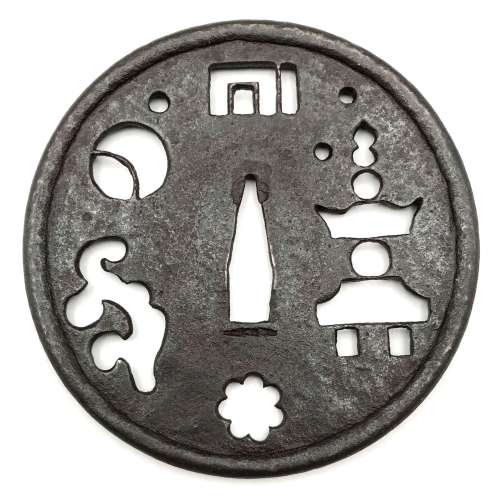 Iron tsuba of round form decorated with design of moon, stars, cloud, snowflake, gorintō, and Genji-mon in negative openwork (in-sukashi). Raised tubular rim (dote-mimi). Deep black patina, traces of lacquer. Naka-daka type of plate (thicker in center, getting thiner towards the rim). Visible gap between the rim and the plate. Dimensions: Height: 91.7 mm; Width: 90.8 mm; Thickness at seppa-dai: 2.5 mm, plate before rim: 2.2 mm, of the rim: 5.6 mm. At least Mid Muromachi period, 15th century, but possibly earlier. In 'Silver Book', commenting tsuba №34 Sasano writes: "The technique used to create the rim is the same used for the peak (koshimaki) of helmets (kabuto) during the Kamakura and Nanbokucho periods." On the other hand, the abundance of sukashi elements points towards later times, perhaps late Muromachi or even Momoyama period. "Gorintō is a grave stone composed of five pieces, piled on one the other, representing, from the bottom upward, earth, water, fire, wind, and heaven, respectively" [Nihon Tō Kōza, Volume VI, Part 1. AFU, 1993, p. 6. / LIB-1554]. A romantic description of the piece may look like this: The air is scented (incense symbol); it's a graveyard, marked by gorintō; a winter (snowflake) evening or night (moon, stars); mist is rising from a ravine towards moon. I did not manage to find a katchūshi piece of this design, only a few Kamakura-bori tsuba:
Iron tsuba of round form decorated with design of moon, stars, cloud, snowflake, gorintō, and Genji-mon in negative openwork (in-sukashi). Raised tubular rim (dote-mimi). Deep black patina, traces of lacquer. Naka-daka type of plate (thicker in center, getting thiner towards the rim). Visible gap between the rim and the plate. Dimensions: Height: 91.7 mm; Width: 90.8 mm; Thickness at seppa-dai: 2.5 mm, plate before rim: 2.2 mm, of the rim: 5.6 mm. At least Mid Muromachi period, 15th century, but possibly earlier. In 'Silver Book', commenting tsuba №34 Sasano writes: "The technique used to create the rim is the same used for the peak (koshimaki) of helmets (kabuto) during the Kamakura and Nanbokucho periods." On the other hand, the abundance of sukashi elements points towards later times, perhaps late Muromachi or even Momoyama period. "Gorintō is a grave stone composed of five pieces, piled on one the other, representing, from the bottom upward, earth, water, fire, wind, and heaven, respectively" [Nihon Tō Kōza, Volume VI, Part 1. AFU, 1993, p. 6. / LIB-1554]. A romantic description of the piece may look like this: The air is scented (incense symbol); it's a graveyard, marked by gorintō; a winter (snowflake) evening or night (moon, stars); mist is rising from a ravine towards moon. I did not manage to find a katchūshi piece of this design, only a few Kamakura-bori tsuba: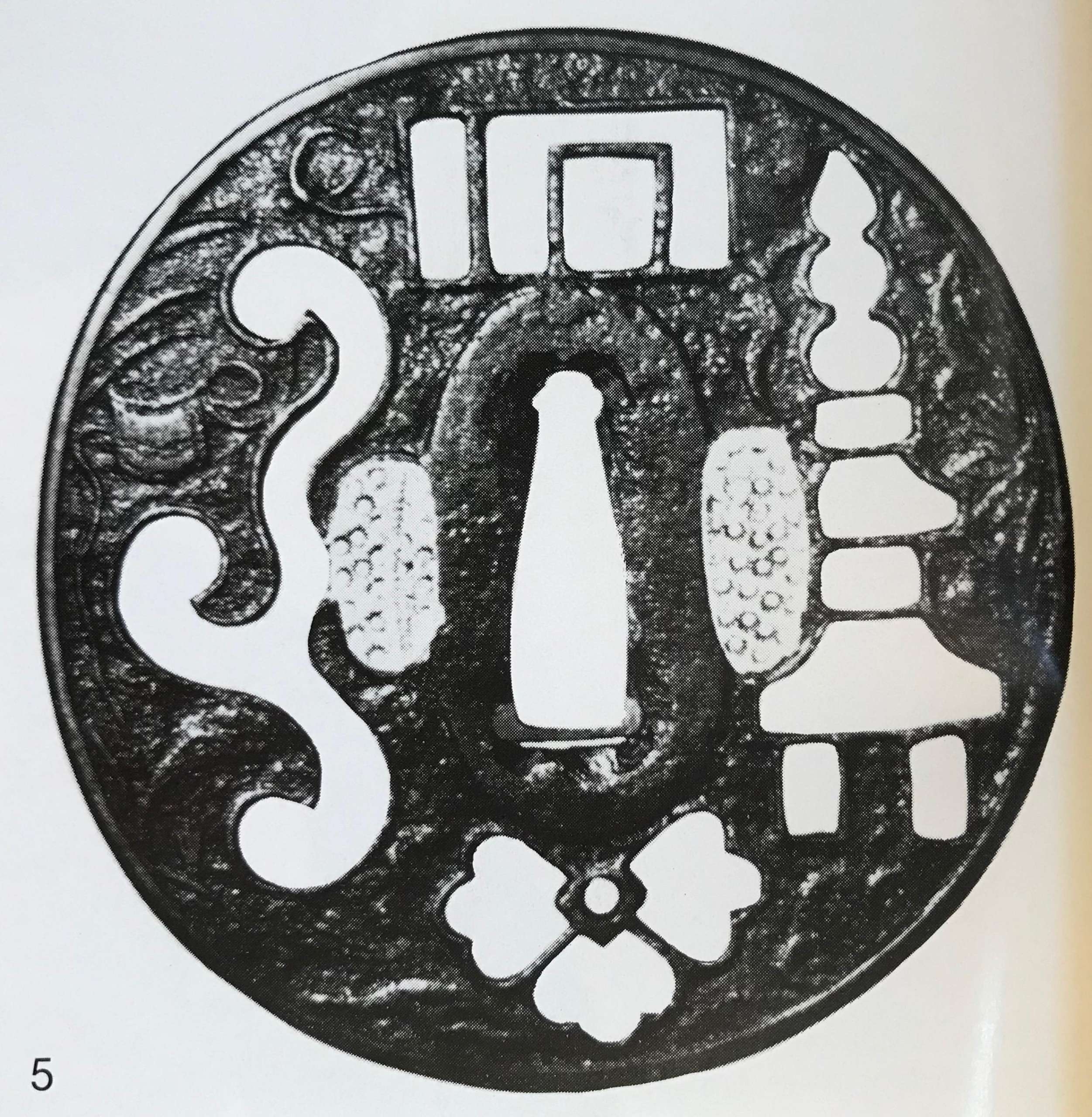
100 selected tsuba from European collections. Catalogue by Robert Haynes and Robert Burawoy, 1984, page 16, №5.
While the upper tsuba is dated the end of Muromachi, the lower is attributed to the 17th century - Momoyama or early Edo period, though the author put this attribution under question. Deciphering of the strangely shaped opening to the left of nakago-ana is sometimes "a conventional scroll", and sometimes - a fern or bracken. I think mine is a cloud or mist, but I don't have any material evidence to prove this understanding, and I came to a conclusion based only on context. It may easily be dinosaurs playing ball. The fact that this thing always accompanies the Genji-mon, or incense symbol, it may be a scent itself.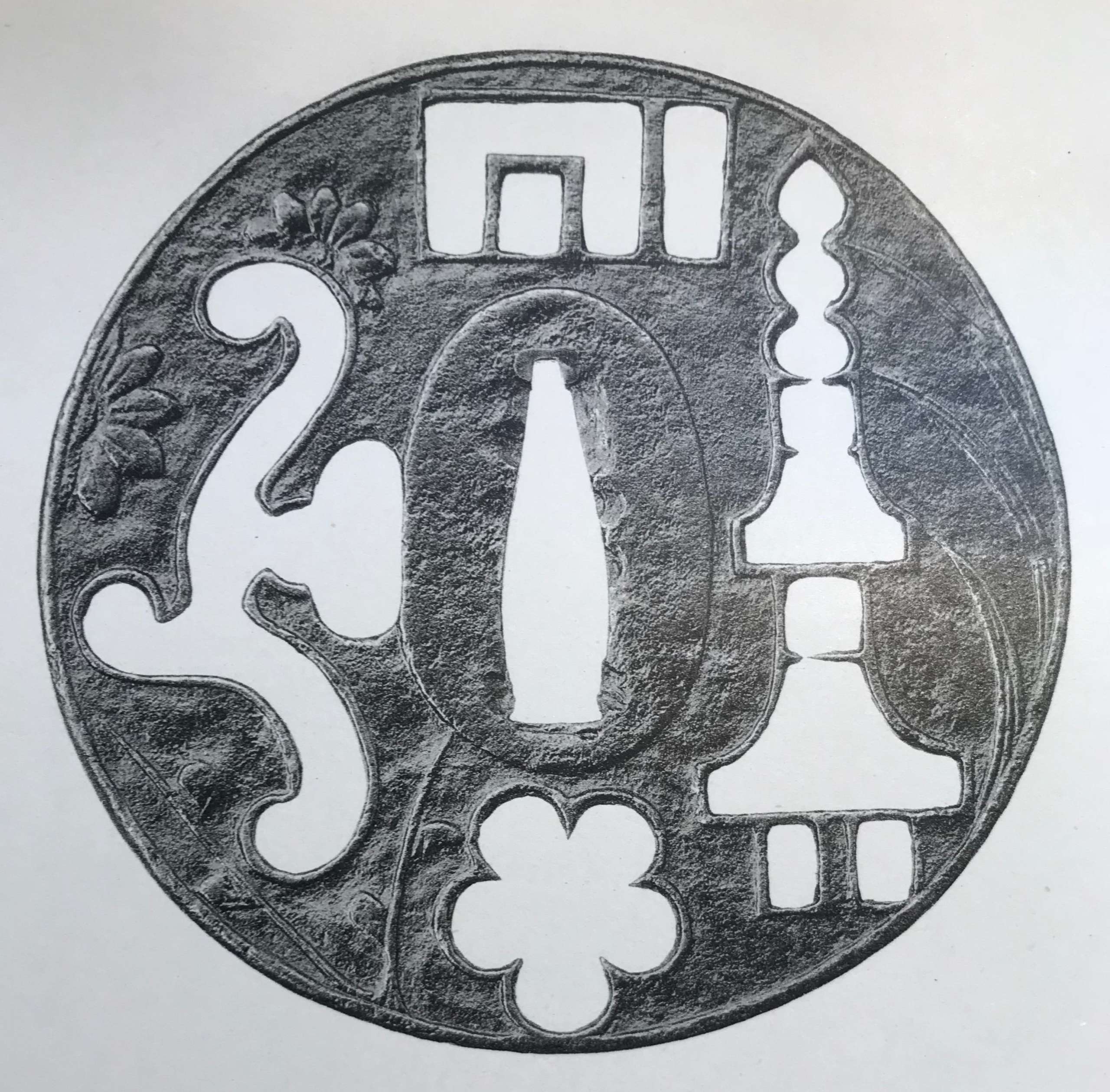
Japanese Sword Fittings. Collection of G.H. Naunton, Esq., by Henri L. Joly, - 1912; №9.
-
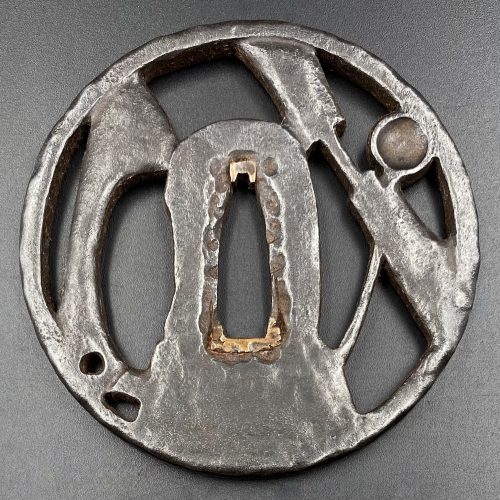 Iron tsuba of round form decorated with a ladle, pestle, mortar, and rice sickle in positive silhouette openwork (nikubori-ji-sukashi). Slightly rounded rim with iron bones (tekkotsu). Seppa-dai plugged with copper fittings (sekigane). Silver patina. The design resembles mochi-making utensils; mochi (rice cake) symbolizes longevity. Kanayama school, c. 1590 (Momoyama period). Note: unusually large size for a Kanayama tsuba: diameter 79.5 mm, thickness at seppa-dai: 5.5 mm, at rim: 6.0 mm. Concerning the design: While the ladle and pestle are clear, the mortar (under the seppa-dai), and the sickle (to the left) require certain imagination.
Iron tsuba of round form decorated with a ladle, pestle, mortar, and rice sickle in positive silhouette openwork (nikubori-ji-sukashi). Slightly rounded rim with iron bones (tekkotsu). Seppa-dai plugged with copper fittings (sekigane). Silver patina. The design resembles mochi-making utensils; mochi (rice cake) symbolizes longevity. Kanayama school, c. 1590 (Momoyama period). Note: unusually large size for a Kanayama tsuba: diameter 79.5 mm, thickness at seppa-dai: 5.5 mm, at rim: 6.0 mm. Concerning the design: While the ladle and pestle are clear, the mortar (under the seppa-dai), and the sickle (to the left) require certain imagination. -
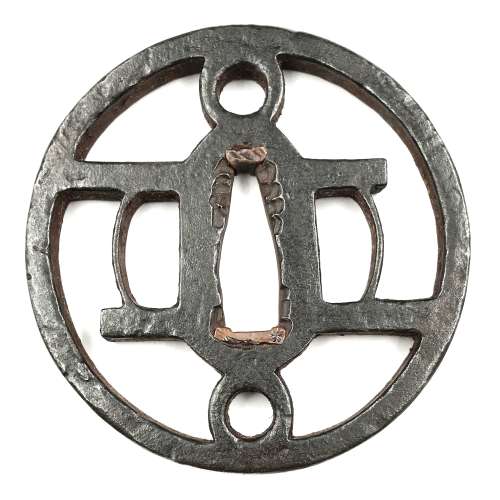 Iron tsuba of round form with design of two parallel crossbars and two rings in openwork (sukashi). Rounded square rim. Moderate iron bones (tekkotsu) allover. Copper sekigane. Kanayama school. Momoyama period (or late Muromachi). Size: 74.5 x 74.0 x 5.5 mm. The rings possibly represent the sun and the moon, or the stars. The parallel crossbars may represent the "two stripes" (futatsu biki) family crest (incl. Ashikaga family).
Iron tsuba of round form with design of two parallel crossbars and two rings in openwork (sukashi). Rounded square rim. Moderate iron bones (tekkotsu) allover. Copper sekigane. Kanayama school. Momoyama period (or late Muromachi). Size: 74.5 x 74.0 x 5.5 mm. The rings possibly represent the sun and the moon, or the stars. The parallel crossbars may represent the "two stripes" (futatsu biki) family crest (incl. Ashikaga family). -
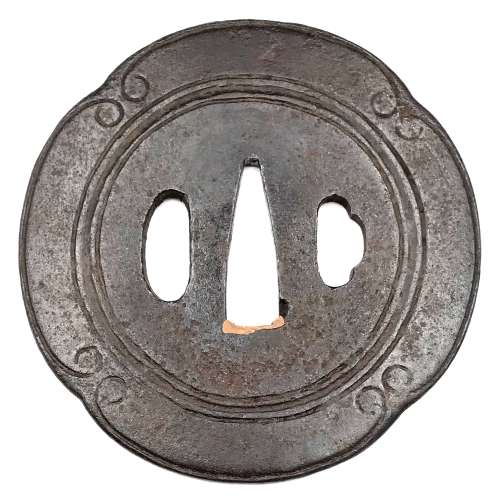 The thin, four-lobed iron plate of brownish color is carved on each side with two concentric grooves in the middle of the web, and with four thin scroll lines (handles, kan) that follow the shape of the rim. The hitsu-ana were added at a later date. Copper sekigane. Kamakura-bori school. Muromachi period, circa 1400-1550. Size: Height 80.4 mm, width 79.0 mm, thickness 3.2 mm at seppa-dai and 2.7 mm at the rim. Weight: 97.7 g. NBTHK Certificate №4004241: 'Hozon' attestation. As for the motif: the concentric circles is a widespread and generic design. It is described by John W. Dower [The Elements of Japanese Design, 1985, p. 132, #2201-30] as follows: Circle: Enclosure (wa). As a crest by itself, the cirlce carries obvious connotations of perfection, harmony, completeness, integrity, even peace. [...] Ordinary circles are labeled according to their thickness, with terminology ranging from hairline to "snake's eye". The motif that is described by both Compton Collection and R.E. Haynes as "scrolls", presented by John W. Dower as "Handle (kan): Although probably a purely ornamental and nonrepresentational design in origin, over the centuries this motif acquired the label kan, denoting its resemblance to the metal handles traditionally used on chests of drawers. [...] Very possibly the "handle" motif represents an early abstract version of the popular mokko, or melon pattern." Early Chinese Taoists claimed that special melon was associated with the Eastern Paradise of Mount Horai just as life-giving peaches were associated with the Western Paradise of the Kunlun Mountains. [...] A design motif called mokko (also translated as "melon" in accordance with the two ideographs with which it is written) may have nothing to do with the fruit. Mokko designs... are widely used as crests of both private families and Shinto shrines and are repeated as background designs that evoke a sense of classicism" [Symbols of Japan. Merrily Baird, 2001]. There is a look alike tsuba at Dr. Walter A. Compton Collection, 1992, Christie’s auction, Part II, pp. 14-15, №16:
The thin, four-lobed iron plate of brownish color is carved on each side with two concentric grooves in the middle of the web, and with four thin scroll lines (handles, kan) that follow the shape of the rim. The hitsu-ana were added at a later date. Copper sekigane. Kamakura-bori school. Muromachi period, circa 1400-1550. Size: Height 80.4 mm, width 79.0 mm, thickness 3.2 mm at seppa-dai and 2.7 mm at the rim. Weight: 97.7 g. NBTHK Certificate №4004241: 'Hozon' attestation. As for the motif: the concentric circles is a widespread and generic design. It is described by John W. Dower [The Elements of Japanese Design, 1985, p. 132, #2201-30] as follows: Circle: Enclosure (wa). As a crest by itself, the cirlce carries obvious connotations of perfection, harmony, completeness, integrity, even peace. [...] Ordinary circles are labeled according to their thickness, with terminology ranging from hairline to "snake's eye". The motif that is described by both Compton Collection and R.E. Haynes as "scrolls", presented by John W. Dower as "Handle (kan): Although probably a purely ornamental and nonrepresentational design in origin, over the centuries this motif acquired the label kan, denoting its resemblance to the metal handles traditionally used on chests of drawers. [...] Very possibly the "handle" motif represents an early abstract version of the popular mokko, or melon pattern." Early Chinese Taoists claimed that special melon was associated with the Eastern Paradise of Mount Horai just as life-giving peaches were associated with the Western Paradise of the Kunlun Mountains. [...] A design motif called mokko (also translated as "melon" in accordance with the two ideographs with which it is written) may have nothing to do with the fruit. Mokko designs... are widely used as crests of both private families and Shinto shrines and are repeated as background designs that evoke a sense of classicism" [Symbols of Japan. Merrily Baird, 2001]. There is a look alike tsuba at Dr. Walter A. Compton Collection, 1992, Christie’s auction, Part II, pp. 14-15, №16: The description goes: “A kamakurabori type tsuba, Muromachi period, circa 1400. The thin, six-lobed iron plate is carved on each side with a wide groove that follows the shape of the rim, and with six scroll lines and a single thin circular groove. […] The hitsu-ana was added at a later date, circa 1500-1550. Height 8.3 cm, width 8.6 cm, thickness 2.5 mm. The tsuba was initially intended to be mounted on a tachi of the battle type in use from Nambokucho to early Muromachi period (1333-1400)”. Sold at $935.
And another one in Robert E. Haynes Catalog #9 on page 24-25 under №23:
The description goes: “A kamakurabori type tsuba, Muromachi period, circa 1400. The thin, six-lobed iron plate is carved on each side with a wide groove that follows the shape of the rim, and with six scroll lines and a single thin circular groove. […] The hitsu-ana was added at a later date, circa 1500-1550. Height 8.3 cm, width 8.6 cm, thickness 2.5 mm. The tsuba was initially intended to be mounted on a tachi of the battle type in use from Nambokucho to early Muromachi period (1333-1400)”. Sold at $935.
And another one in Robert E. Haynes Catalog #9 on page 24-25 under №23:
 R.E. Haynes description: “Typical later Kamakura-bori style work. This type of plate and carving show the uniform work produced by several schools in the Muromachi period. Some had brass inlay and others were just carved as this one is. The hitsu are later. Ca. 1550. Ht. 8.8 cm, Th. 3.25 mm”. Sold for $175.
R.E. Haynes description: “Typical later Kamakura-bori style work. This type of plate and carving show the uniform work produced by several schools in the Muromachi period. Some had brass inlay and others were just carved as this one is. The hitsu are later. Ca. 1550. Ht. 8.8 cm, Th. 3.25 mm”. Sold for $175.
-
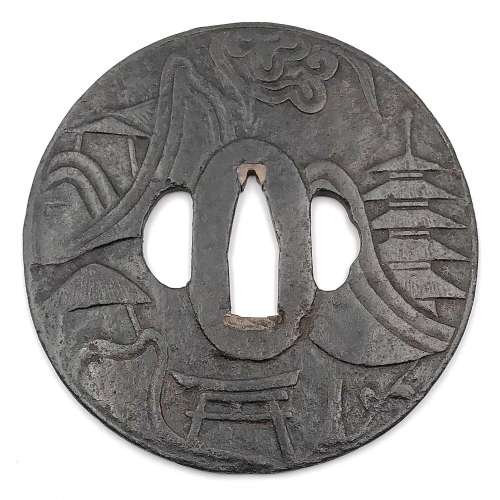
Thin iron plate of round form and black color carved in sukidashi-bori with design of rocks, waves, clouds, temple gates (torii), mountain pavilion and 5-storey pagoda on both sides, alluding to Todai-ji temple in Nara. Hitsu-ana pierced later. Very narrow very slightly raised rim. Copper sekigane.
Late Muromachi period, 16th century. Dimensions: 88.7 x 88.0 x 2.4 mm (seppa-dai), 1.8 mm (base plate).Reference: “Art of the Samurai” on page 232, №140: ”Kamakura tsuba with Sangatsu-do tower and bridge. Muromachi period, 16th century. 83 mm x 80 mm. Unsigned. Tokyo National Museum. The mountain pavilion and bridge carved in sunken relief on the iron tsuba – both part of Tōdai-ji, a temple in Nara – are detailed in fine kebori (line) engraving. As a result of the chiseling used to create the relief, the ground of the piece is relatively thin".
-
 Mokkō-form (kirikomi-mokkō-gata) iron plate of grey colour decorated on both sides with waves, reeds, cloud, pagoda, and thatched hut in low relief (sukidashi-bori). The kozuka-hitsu-ana is original, the kogai-hitsu-ana probably cut later (lacks raised rim, fuchidoru). Wide (5.7 mm) raised rim of rounded square dote-mimi type, decorated with fine cross-hatching. Momoyama period, 16th century. Dimensions: Height: 75.9 mm, width: 76.4 mm, Thickness at seppa-dai: 2.3 mm, at rim 4.4 mm. Kamakura-bori tsuba of such a form is unusual. The rim is also unusual; it is possible that cross-hatching was done as a preparatory step for damascening, or the the damascening (gold or silver) disappeared with passage of time.
Mokkō-form (kirikomi-mokkō-gata) iron plate of grey colour decorated on both sides with waves, reeds, cloud, pagoda, and thatched hut in low relief (sukidashi-bori). The kozuka-hitsu-ana is original, the kogai-hitsu-ana probably cut later (lacks raised rim, fuchidoru). Wide (5.7 mm) raised rim of rounded square dote-mimi type, decorated with fine cross-hatching. Momoyama period, 16th century. Dimensions: Height: 75.9 mm, width: 76.4 mm, Thickness at seppa-dai: 2.3 mm, at rim 4.4 mm. Kamakura-bori tsuba of such a form is unusual. The rim is also unusual; it is possible that cross-hatching was done as a preparatory step for damascening, or the the damascening (gold or silver) disappeared with passage of time.
-
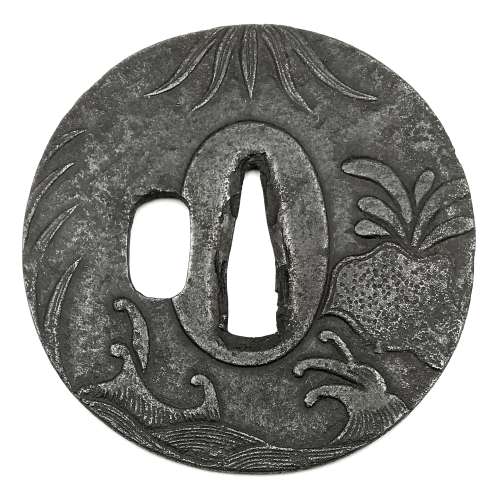 Round iron plate of grey colour decorated in low relief (sukidashi-bori) on the face with sea waves (both layered waves, seigaiha, and rough waves, araumi), sago palm (cycas revoluta, sotetsu), presumably orchid leaves (ran) - five of them - hanging from the above, and reeds (ashi), and on the back with waves (seigaiha only), rocks, chrysanthemums (kiku), clove (chori), reed, and presumably orchid leaves - three of them - hanging from the above. The kozuka-hitsu-ana was probably cut later. The plate is lacking the raised rim, typical for the kamakura-bori school. Muromachi period. Dimensions: Height: 76.8 mm, width: 76.1 mm, Thickness at seppa-dai: 3.3 mm, at rim 2.0 mm. Height of nakago-ana: 29 mm. Weight: 82.4 g. NBTHK certificate № 402152: Hozon - "Worthy of preservation". A similar (most probably the same) tsuba is illustrated and described at Butterfield & Butterfield. IMPORTANT JAPANESE SWORDS, SWORD FITTINGS AND ARMOR. Auction Monday, November 19th, 1979. Sale # 3063 under lot № 66. It describes the piece as following: “Kamakura bori work of the Muromachi period. Round thin plate with some small iron bones in the edge. Carved with design of plants (sego palm) rocks, and waves on the face. The back has half of two chrysanthemums, waves, clove, and sego palm leaves. The kozuka-hitsu has been added and later enlarged. A good typical example without the rim most have. Diameter: 7.7 cm., thickness 2.5 mm. Estimated price $100-200":
Round iron plate of grey colour decorated in low relief (sukidashi-bori) on the face with sea waves (both layered waves, seigaiha, and rough waves, araumi), sago palm (cycas revoluta, sotetsu), presumably orchid leaves (ran) - five of them - hanging from the above, and reeds (ashi), and on the back with waves (seigaiha only), rocks, chrysanthemums (kiku), clove (chori), reed, and presumably orchid leaves - three of them - hanging from the above. The kozuka-hitsu-ana was probably cut later. The plate is lacking the raised rim, typical for the kamakura-bori school. Muromachi period. Dimensions: Height: 76.8 mm, width: 76.1 mm, Thickness at seppa-dai: 3.3 mm, at rim 2.0 mm. Height of nakago-ana: 29 mm. Weight: 82.4 g. NBTHK certificate № 402152: Hozon - "Worthy of preservation". A similar (most probably the same) tsuba is illustrated and described at Butterfield & Butterfield. IMPORTANT JAPANESE SWORDS, SWORD FITTINGS AND ARMOR. Auction Monday, November 19th, 1979. Sale # 3063 under lot № 66. It describes the piece as following: “Kamakura bori work of the Muromachi period. Round thin plate with some small iron bones in the edge. Carved with design of plants (sego palm) rocks, and waves on the face. The back has half of two chrysanthemums, waves, clove, and sego palm leaves. The kozuka-hitsu has been added and later enlarged. A good typical example without the rim most have. Diameter: 7.7 cm., thickness 2.5 mm. Estimated price $100-200":
Butterfield & Butterfield, 1979. Sale # 3063, lot № 66.
-
 Six-lobed iron tsuba in a form of three ginkgo tree leaves (icho), separated with three small triangular openings (ko-sukashi). Leaves have raised rim and decorated with various family crests (mon) in low relief carving (sukidashi-bori). On obverse: bamboo stems and leaves, knotted geese, paulownia (kiri), plum blossom (ume), and ivy. On reverse: pine needles and cone, maple leaf (kaede), bamboo, stylized plum blossom, and Genji-mon. Black patina. Kozuka hitsu-ana is original, with raised rim. Copper sekigane. Kamakura-bori school. Late Muromachi period (ca. 1550). Size: Height: 81.1 mm. Width: 90.0 mm. Thickness at seppa-dai: 3.3 mm. Weight: 120.4 g.
Six-lobed iron tsuba in a form of three ginkgo tree leaves (icho), separated with three small triangular openings (ko-sukashi). Leaves have raised rim and decorated with various family crests (mon) in low relief carving (sukidashi-bori). On obverse: bamboo stems and leaves, knotted geese, paulownia (kiri), plum blossom (ume), and ivy. On reverse: pine needles and cone, maple leaf (kaede), bamboo, stylized plum blossom, and Genji-mon. Black patina. Kozuka hitsu-ana is original, with raised rim. Copper sekigane. Kamakura-bori school. Late Muromachi period (ca. 1550). Size: Height: 81.1 mm. Width: 90.0 mm. Thickness at seppa-dai: 3.3 mm. Weight: 120.4 g. -
 Iron tsuba of round form pierced with design of paulownia (kiri) in a circle in positive silhouette (ji-sukashi), details carved in low relief (sukidashi-bori). Hitsu-ana were cut later and then both plugged with lead or pewter. Brown patina. The most unusual characteristic of this tsuba is its 'positiveness': the absolute majority of Kamakura-bori tsuba are of ko-sukashi type, i.e. with small openings, presenting the motif in negative silhouette. Kamakura-bori school. Muromachi period (ca. 1450). Size: Height: 85.1 mm, width: 84.8 mm, thickness at seppa-dai: 3.2 mm, at rim: 2.8 mm. Weight: 79.1 g. A similar tsuba is presented at Japanese Swords and Sword Fittings from the Collection of Dr. Walter Ames Compton. Part I. Christie's, New York, March 31, 1992, page 11, №3: "A Kamakura-bori tsuba. Muromachi period, ca. 1450. The round iron plate is pierced with an openwork design of a paulownia crest (kiri-mon), the surface details of which are carved in low relief. The design is repeated on the reverse. The edge is slightly raised and the rim has some iron bones. 78 mm x 77 mm x 3.5 mm. Hakogaki by Sato Kanzan, dated summer 1973."
Iron tsuba of round form pierced with design of paulownia (kiri) in a circle in positive silhouette (ji-sukashi), details carved in low relief (sukidashi-bori). Hitsu-ana were cut later and then both plugged with lead or pewter. Brown patina. The most unusual characteristic of this tsuba is its 'positiveness': the absolute majority of Kamakura-bori tsuba are of ko-sukashi type, i.e. with small openings, presenting the motif in negative silhouette. Kamakura-bori school. Muromachi period (ca. 1450). Size: Height: 85.1 mm, width: 84.8 mm, thickness at seppa-dai: 3.2 mm, at rim: 2.8 mm. Weight: 79.1 g. A similar tsuba is presented at Japanese Swords and Sword Fittings from the Collection of Dr. Walter Ames Compton. Part I. Christie's, New York, March 31, 1992, page 11, №3: "A Kamakura-bori tsuba. Muromachi period, ca. 1450. The round iron plate is pierced with an openwork design of a paulownia crest (kiri-mon), the surface details of which are carved in low relief. The design is repeated on the reverse. The edge is slightly raised and the rim has some iron bones. 78 mm x 77 mm x 3.5 mm. Hakogaki by Sato Kanzan, dated summer 1973."
Compton's Collection, Part I, p. 11, №3.
-
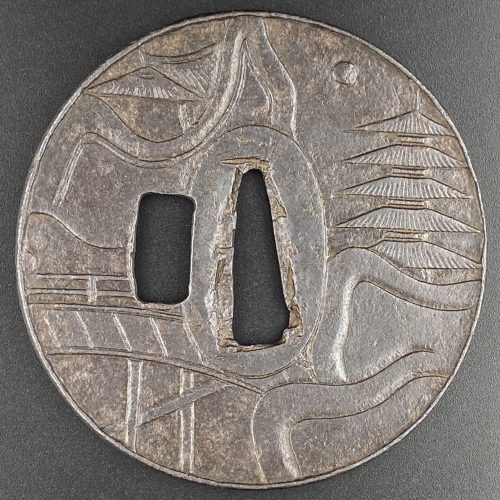
The thin iron plate of round form and black colour carved in sukidashi-bori with the design of rocks, waves, bridge, mountain pavilion and 5-storey pagoda under the moon, on both sides, alluding to Todai-ji temple in Nara. Slightly rounded rectangular hitsu-ana probably pierced later. Very narrow raised rim as usual in katsushi tsuba. In a modern wooden box.
Late Muromachi period, 16th century. Dimensions: 81.1 x 79.5 x 3. mm (seppa-dai), 2.2 mm (base plate), 4.4. (rim).Reference: “Art of the Samurai” on page 232, №140: ”Kamakura tsuba with Sangatsu-do tower and bridge. Muromachi period, 16th century. 83 mm x 80 mm. Unsigned. Tokyo National Museum. The mountain pavilion and bridge carved in sunken relief on the iron tsuba – both part of Tōdai-ji, a temple in Nara – are detailed in fine kebori (line) engraving. As a result of the chiselling used to create the relief, the ground of the piece is relatively thin”. Also page 41 in Tsuba Kanshoki. Kazutaro Torogoye, 1975 [LIB-1480.2018].
This tsuba is very much similar to TSU-0384. -
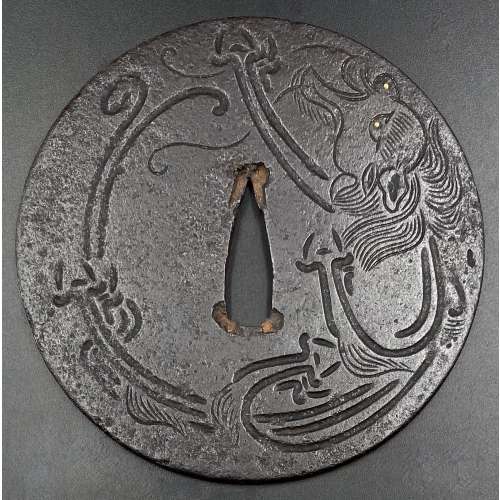 Iron tsuba of round form, on both sides decorated in low relief (kebori) with a dragon, eyes inlaid in brass. NBTHK: Hozon, № 4011013. Kamakura-bori type of tsuba. Med-Muromachi period, c. 1450. Diameter: 90 mm; Thickness (centre): 3.3 cm, Thickness (rim): 2.4 cm Reference: Japanese Swords and Sword Fittings from the Collection of Dr Walter Ames Compton (Part I). — NY: Christie's, 1992, p. 10, №2. Obviously, Compton's tsuba has an altered nakago-ana and placed on the photo upside down. Compton's tsuba has a raised mimi, while mine does not.
Iron tsuba of round form, on both sides decorated in low relief (kebori) with a dragon, eyes inlaid in brass. NBTHK: Hozon, № 4011013. Kamakura-bori type of tsuba. Med-Muromachi period, c. 1450. Diameter: 90 mm; Thickness (centre): 3.3 cm, Thickness (rim): 2.4 cm Reference: Japanese Swords and Sword Fittings from the Collection of Dr Walter Ames Compton (Part I). — NY: Christie's, 1992, p. 10, №2. Obviously, Compton's tsuba has an altered nakago-ana and placed on the photo upside down. Compton's tsuba has a raised mimi, while mine does not.
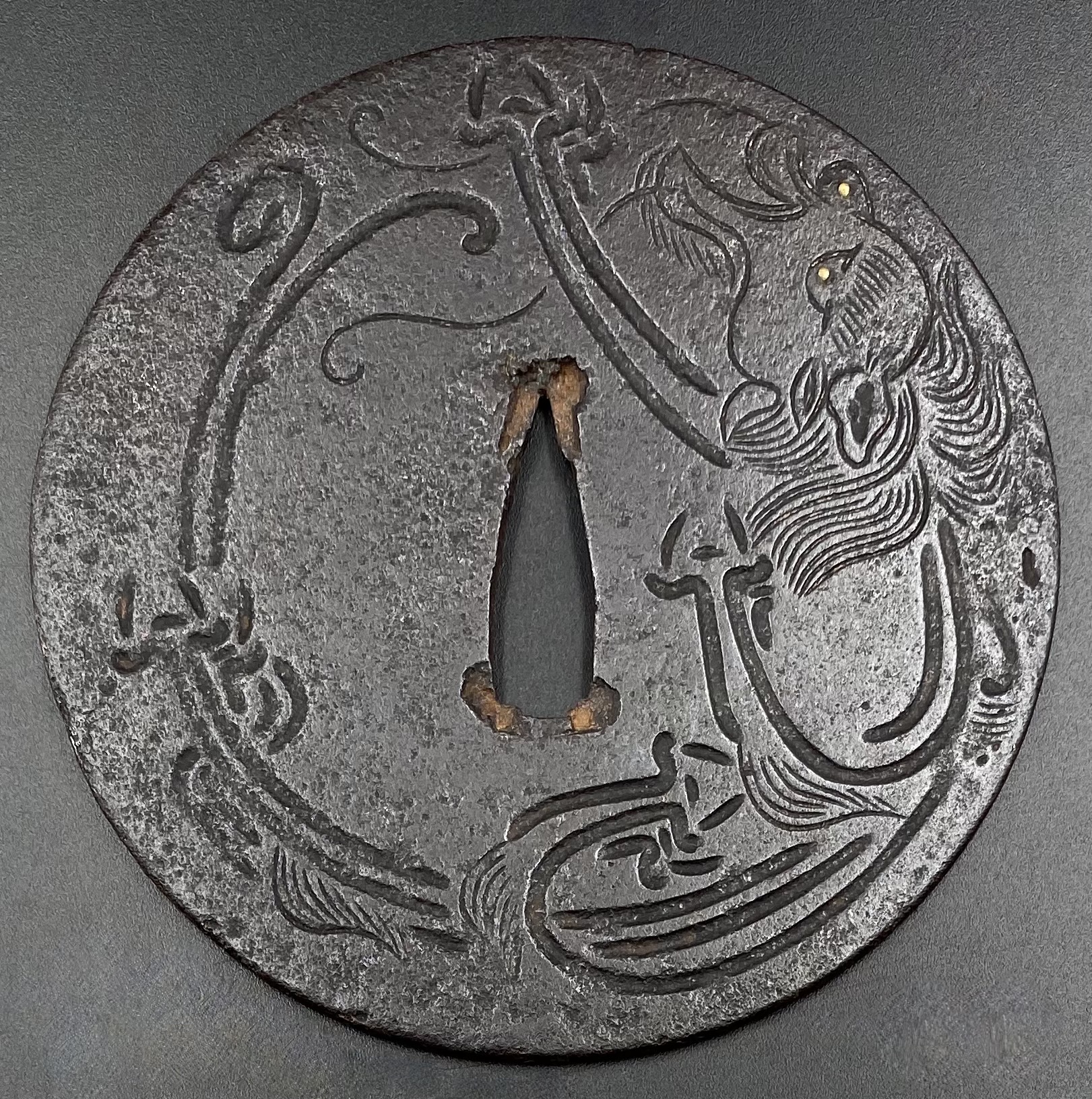 Two other examples of the same design may be found at: (1) Christie, Manson & Woods auction sales “Kotetsu”, 1980, page 12, №10 and (2) Professor A. Z. Freeman and the Phyllis Sharpe Memorial collections №36, pp. 18-19. Both have raised mimi, the latter classified as Katchushi tsuba.
More about Kamakura-bori tsuba here.
Two other examples of the same design may be found at: (1) Christie, Manson & Woods auction sales “Kotetsu”, 1980, page 12, №10 and (2) Professor A. Z. Freeman and the Phyllis Sharpe Memorial collections №36, pp. 18-19. Both have raised mimi, the latter classified as Katchushi tsuba.
More about Kamakura-bori tsuba here.
-
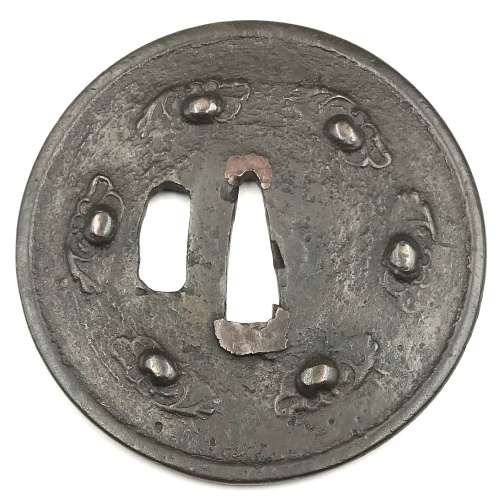 Circular form tsuba made by a mirror-maker, i.e. kagamishi. Cast yamagane plate with design of six persimmons on their peduncles surrounded by leaves. Slightly raised rounded square rim. Hitsu-ana is brutally cut later in time. Copper sekigane. Early Muromachi period (1393-1457) or earlier. The inscription on the box reads: "Kamakura or Muromachi Period. Yamagane Tsuba". Dimensions: 81.9 x 81.6 mm; thickness at seppa-dai 2.8 - 3.0 mm, rim 3.4 mm.
Circular form tsuba made by a mirror-maker, i.e. kagamishi. Cast yamagane plate with design of six persimmons on their peduncles surrounded by leaves. Slightly raised rounded square rim. Hitsu-ana is brutally cut later in time. Copper sekigane. Early Muromachi period (1393-1457) or earlier. The inscription on the box reads: "Kamakura or Muromachi Period. Yamagane Tsuba". Dimensions: 81.9 x 81.6 mm; thickness at seppa-dai 2.8 - 3.0 mm, rim 3.4 mm. -
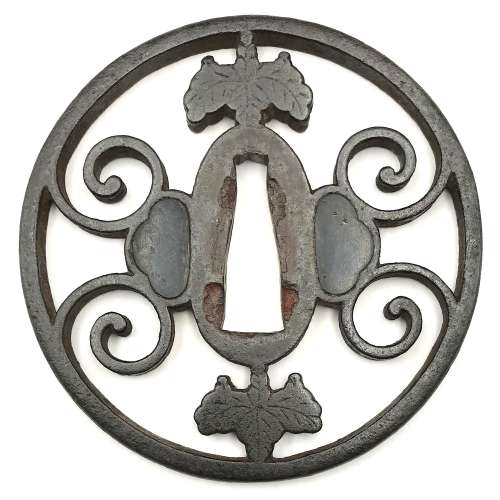
Iron tsuba of round form decorated with a design of bracken scrolls and paulownia leaves and blossoms (kiri-mon) in openwork (sukashi). Details carved in kebori. Squared rim with iron bones (tekkotsu). Hitsu-ana plugged with shakudō.
Size: 83.6 x 82.9 x 5.4 (center), 5.1 (rim) mm.
Unsigned.
Muromachi period, ca. 16th century.
-
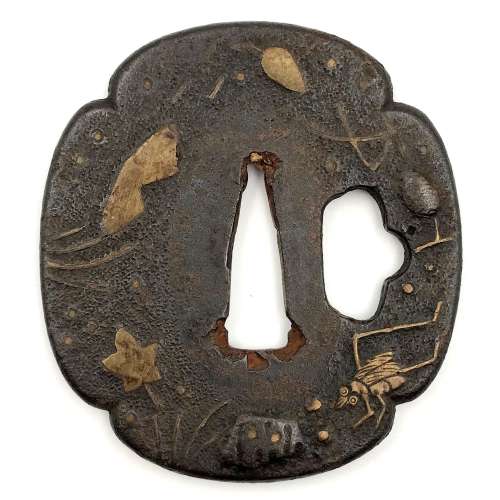 Iron tsuba of four-lobbed mokkō form decorated in brass and shakudō inlay on the face with design of rotten skull, fly, maple leaf, pine cones and needles, and on the back with design of rotten skull, wild boar, pine cones and needles. Scattered brass dots on both sides. Hitsu-ana possibly cut off later. Surface has traces of lacquer (urushi). Momoyama period. Dimensions: 67.3 x 61.5 x 4.3 mm A similar example can be found at Tsuba Kanshoki by Kazutaro Torogoye, 1975 on p. 61: "Heianjōzōgan tsuba. No sig. Iron: Pine-cone, seeds, ants & rock, brass zōgan. Kakumimi: C. 1.5 bu. Age: Momoyama. Sup. - Early work. Interest."
Iron tsuba of four-lobbed mokkō form decorated in brass and shakudō inlay on the face with design of rotten skull, fly, maple leaf, pine cones and needles, and on the back with design of rotten skull, wild boar, pine cones and needles. Scattered brass dots on both sides. Hitsu-ana possibly cut off later. Surface has traces of lacquer (urushi). Momoyama period. Dimensions: 67.3 x 61.5 x 4.3 mm A similar example can be found at Tsuba Kanshoki by Kazutaro Torogoye, 1975 on p. 61: "Heianjōzōgan tsuba. No sig. Iron: Pine-cone, seeds, ants & rock, brass zōgan. Kakumimi: C. 1.5 bu. Age: Momoyama. Sup. - Early work. Interest."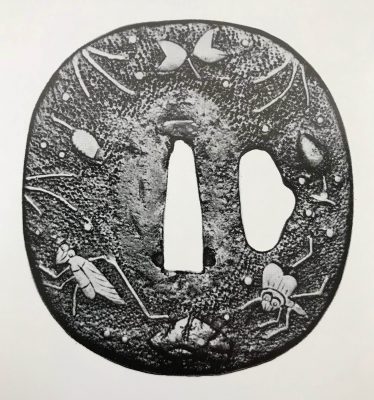
Tsuba Kanshoki, 1975, p. 61: Heianjō tsuba, Momoyama Period.
-

Tsuba of oval form decorated with clematis six-petal flowers, tendrils, and leaves in cast brass with details carved in kebori, inlaid on iron plate carved in low relief (kebori and sukidashi-bori). Hitsu-ana plugged with shakudō. Copper sekigane.
Heianjō (or Ōnin) school. Unsigned. Mid Muromachi period (1454-1513). Dimensions: 87.2 x 84.3 x 4.3 mm. Tsuba is illustrated and described in Gary D. Murtha's "Onin-Heianjo-Yoshiro" book on pages 38-39. Mid-Muromachi is the age attribution by Gary. “A picture book of Japanese sword guards. Victoria & Albert Museum“, published in 1927 presents us with a somewhat similar tsuba: "Floral ornament. Iron, with brass incrustation". V&A attributes the tsuba to Ōnin style, 16th century.
-
 Heianjō tsuba, carved and inlayed in brass with a somewhat primitive design of rocks, plants, and waves, and a man in a boat beside two jakugo stone baskets on the face and a religious structure (stupa, grave stone) on the reverse. Muromachi or Momoyama period.
Heianjō tsuba, carved and inlayed in brass with a somewhat primitive design of rocks, plants, and waves, and a man in a boat beside two jakugo stone baskets on the face and a religious structure (stupa, grave stone) on the reverse. Muromachi or Momoyama period.Size: 83.2 x 82.4 x 3.6 mm; 149.2 g
The Carlo Monzino Collection of Japanese sword fittings and swords (Sotheby's, London, 18 June 1996. p. 12-13) №9 provides an illustration of the similar tsuba with the following description: Heianjo tsuba, carved and inlayed with rocks, plants, and waves, also pierced with a jakago [sic] (stone basket).
Gary D. Murtha in his Japanese sword guards Onin - Heianjo - Yoshiro (GDM Publications, 2016) on page 53 shows a look-a-like tsuba (though, with a kogai-hitsu-ana) with the follwoing description: Iron, 77 mm, tsuba with brass tree, snake, jakugo baskets, and curved brass pieces (representing water flowing over rocks). Buddhist halo to reverse. Although showing Onin traits, a Shoami Heiamjo attribution would fit better. Azuchi-Momoyama period.

-

Thin iron tsuba of round form pierced with six three-leaf wood sorrels (katabami) in ko-sukashi and inlaid with brass decoration along the rim. Kozuka-hitsu-ana probably cut at a later date.
Late Muromachi or Momoyama period, 16th century. Dimensions: 78.0 x 77.7 x 2.5 mm.


